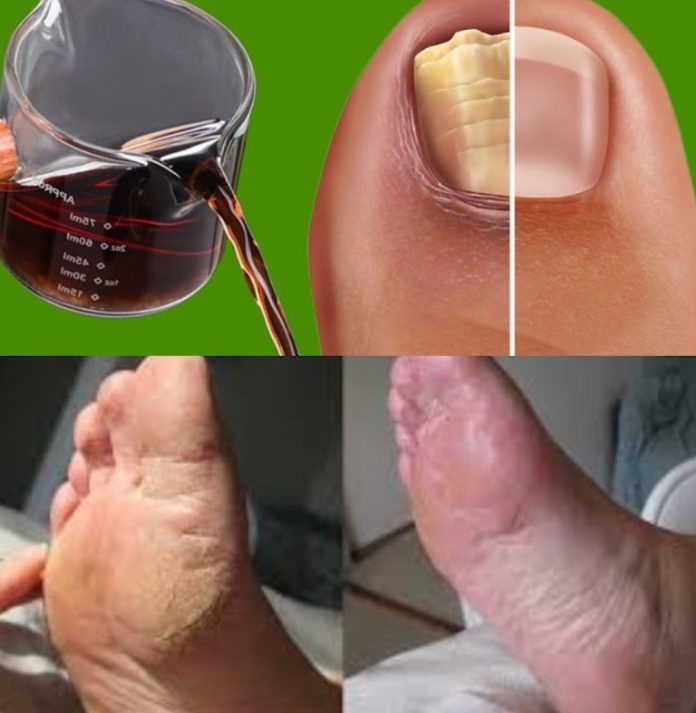Nail fungus, medically known as onychomycosis, can be a persistent and unsightly issue. It often appears as yellow or whitish discoloration, thickening, or crumbling at the edges of nails. This common condition can affect both fingernails and toenails, and if left untreated, it may become quite uncomfortable or even painful. Fortunately, there’s an effective and natural remedy waiting in most kitchens: vinegar.
Known for its antifungal properties, vinegar can be a safe, affordable solution to treat nail fungus naturally. Read on to discover how to use vinegar-based treatments to restore health and shine to your nails.
Why Vinegar Works: The Science Behind It
The key to vinegar’s effectiveness lies in its acidity. Both white vinegar and apple cider vinegar contain acetic acid, which creates an environment that is inhospitable to fungi, bacteria, and other pathogens. This acidic environment prevents fungal growth and supports the health of your nails. Regularly applying vinegar helps to cleanse the nails and prevents the spread of infection to other parts of the body or to others.
Methods for Using Vinegar to Combat Nail Fungus
1. Basic Vinegar Soak
This simple yet effective method is great for anyone looking to treat nail fungus in a straightforward way. Here’s how you can use a vinegar soak to begin the healing process:
Ingredients:
- 1 cup of white vinegar or apple cider vinegar
- 2 cups of warm water
- A large bowl for soaking
Instructions:
- Prepare the Soak: Combine the vinegar with warm water in a large bowl, maintaining a 1:2 vinegar-to-water ratio. This ratio helps dilute the vinegar enough to avoid irritation but still keeps it strong enough to be effective against fungal growth.
- Soak Your Nails: Place your hands or feet in the bowl and soak the affected nails for 15–20 minutes. The warm water helps soften the nails, allowing the vinegar to penetrate and act more effectively.
- Rinse and Dry Thoroughly: After soaking, rinse your nails with clean water and dry them well with a towel. It’s essential to keep nails dry, as moisture can encourage fungus.
- Repeat Daily: Consistency is key. Do this soak once or twice daily, as it can take a few weeks to see full results depending on the severity of the infection.
2. Vinegar and Baking Soda Paste
For a slightly stronger treatment, vinegar and baking soda can be used together. Baking soda has mild abrasive properties that help remove dead skin and infected nail tissue, while vinegar provides the antifungal effect.
Ingredients:
- 2 tablespoons white vinegar or apple cider vinegar
- 2 tablespoons baking soda
- Small mixing bowl
Instructions:
- Mix the Paste: Combine vinegar and baking soda in a bowl, stirring until it forms a thick paste. This mixture combines the acidic power of vinegar with the exfoliating benefits of baking soda.
- Apply to Affected Nails: Spread the paste over the infected nails and surrounding skin, ensuring you cover the nail beds and cuticles for maximum effect.
- Let it Sit: Allow the paste to sit on your nails for about 15 minutes, giving the mixture time to penetrate the nail and skin.
- Rinse and Dry: Rinse your nails with warm water, and dry them completely.
- Repeat Daily: Use this paste treatment once a day until the infection clears up.
3. Vinegar and Essential Oils Treatment
For an enhanced approach, adding essential oils with antifungal properties to vinegar can improve the effectiveness of your treatment. Tea tree oil, for example, is known for its ability to fight fungi, while lavender oil provides soothing and calming effects.
Ingredients:
- ½ cup of white or apple cider vinegar
- 10 drops of tea tree oil or lavender oil
- Small bottle or jar for storage
Instructions:
- Mix Ingredients: In a small bottle, combine vinegar with tea tree or lavender essential oil. Shake gently to mix well.
- Apply to Nails: Using a cotton ball or swab, apply the mixture to affected nails, making sure to reach under and around each nail.
- Let Air Dry: Allow the solution to dry on your nails naturally. Avoid rinsing to allow continued antifungal action.
- Repeat Daily: Apply once or twice daily for best results.
Tips for Maintaining Healthy Nails
- Trim Regularly: Cutting nails frequently helps control fungus and allows vinegar treatments to work better.
- Choose Breathable Footwear: Opt for shoes made from breathable materials to prevent moisture buildup, as damp environments encourage fungal growth.
- Wash and Dry Thoroughly: Make it a habit to wash and dry your hands and feet, especially after sweating or spending time in damp environments like gyms and pools.
- Moisturize Naturally: Once your nails start to heal, keep them hydrated with natural moisturizers like coconut oil, which helps maintain healthy cuticles and nourished nail beds.
Conclusion :
Vinegar offers a natural, affordable way to treat nail fungus without the harsh chemicals found in many over-the-counter treatments. With patience and consistency, vinegar-based treatments can help eliminate fungal infections and restore the beauty and health of your nails.
By adding these easy steps to your daily routine, you’re not only improving your nails’ appearance but also keeping them strong and fungus-free over time. With continued care, you’ll be on your way to achieving healthy, shiny nails naturally.










